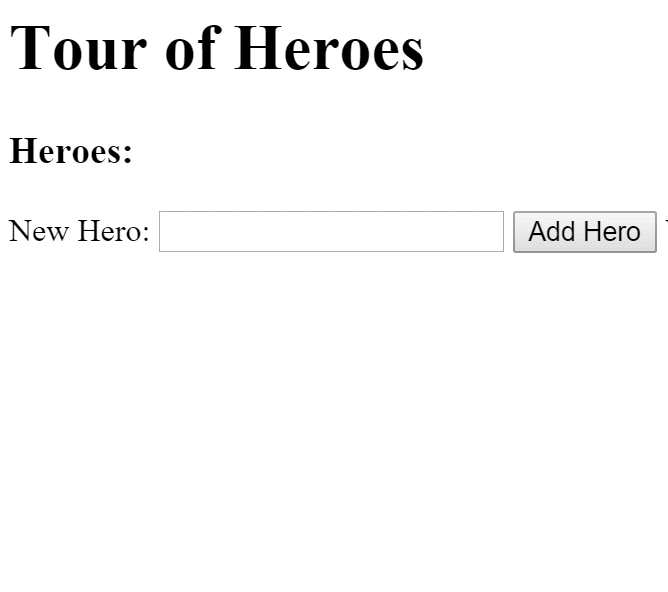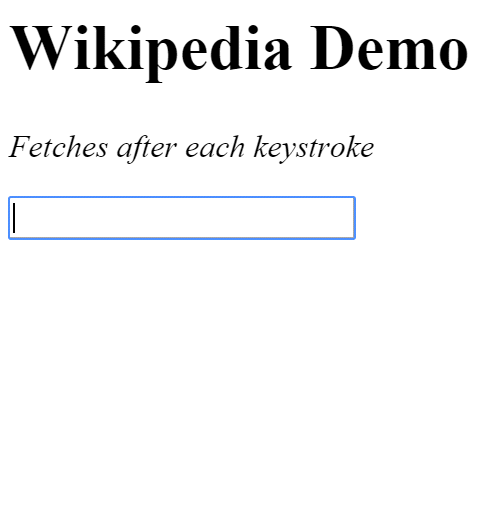HTTP is the primary protocol for browser/server communication.
The WebSocket protocol is another important communication technology;
we won't cover it in this chapter.
Modern browsers support two HTTP-based APIs: XMLHttpRequest (XHR) and JSONP. A few browsers also support Fetch.
The Dart http library simplifies application programming of the XHR and JSONP APIs as we'll learn in this chapter covering:
- HTTP client sample overview
- Fetch data with http.get
- RxJS Observable of HTTP Responses
- Enabling RxJS Operators
- Extract JSON data
- Error handling
- Send data to the server
- Promises instead of observables
- Cross-origin requests: Wikipedia example
- Appendix: the in-memory web api service
We illustrate these topics with code that you can
Demos
This chapter describes server communication with the help of the following demos
- HTTP client: Tour of Heroes
- JSONP client: Wikipedia to fetch data from a service that does not support CORS (under development)
These demos are orchestrated by the root AppComponent
lib/app_component.dart
First, we have to configure our application to use server communication facilities.
Providing HTTP Services
We use the Dart BrowserClient client to communicate with a server using a familiar HTTP request/response protocol.
The BrowserClient client is one of a family of services in the Dart http library.
Before we can use the BrowserClient client , we'll have to register it as a service provider with the Dependency Injection system.
Learn about providers in the Dependency Injection chapter.
In this demo, we register providers in the bootstrap() method of
app/main.ts.
web/main.dart (v1)
Actually, it is unnecessary to include BrowserClient in the list of providers.
But as is mentioned in the Angular Dart Transformer wiki page,
the template compiler generates dependency injection code, hence all the
identifiers used in DI have to be collected by the Angular transformer
so that the libraries containing these identifiers can be transformed.
Unless special steps are taken, Dart libraries like http
are not transformed. To ensure that the BrowserClient identifier is available
for DI, we must add a resolved_identifiers parameter to the angular2
transformer in pubspec.yaml:
pubspec.yaml (transformers)
The Tour of Heroes HTTP Client Demo
Our first demo is a mini-version of the tutorial's "Tour of Heroes" (ToH) application.
This version gets some heroes from the server, displays them in a list, lets us add new heroes, and saves them to the server.
We use the Dart BrowserClient client to communicate via XMLHttpRequest (XHR).
It works like this.

This demo has a single component, the HeroListComponent. Here's its template:
lib/toh/hero_list_component.html (template)
It presents the list of heroes with an ngFor.
Below the list is an input box and an Add Hero button where we can enter the names of new heroes
and add them to the database.
We use a template reference variable, newHeroName, to access the
value of the input box in the (click) event binding.
When the user clicks the button, we pass that value to the component's addHero method and then
clear it to make it ready for a new hero name.
Below the button is an area for an error message.
The HeroListComponent class
Here's the component class:
lib/toh/hero_list_component.dart (class)
Angular injects a HeroService into the constructor
and the component calls that service to fetch and save data.
The component does not talk directly to the Dart BrowserClient client!
The component doesn't know or care how we get the data.
It delegates to the HeroService.
This is a golden rule: always delegate data access to a supporting service class.
Although at runtime the component requests heroes immediately after creation,
we do not call the service's get method in the component's constructor.
We call it inside the ngOnInit lifecycle hook instead
and count on Angular to call ngOnInit when it instantiates this component.
This is a best practice. Components are easier to test and debug when their constructors are simple and all real work (especially calling a remote server) is handled in a separate method.
The hero service getHeroes() and addHero() asynchronous methods return the
Future
values of the current hero list and the newly added hero,
respectively. The hero list component methods of the same name specifying
the actions to be taken when the asynchronous method calls succeed or fail.
For more information about Futures, consult any one
of the articles on asynchronous
programming in Dart, or the tutorial on
Asynchronous Programming: Futures.
With our basic intuitions about the component squared away, we're ready to look inside the HeroService.
Fetch data with the HeroService
In many of our previous samples we faked the interaction with the server by returning mock heroes in a service like this one:
In this chapter, we revise that HeroService to get the heroes from the server using the Dart BrowserClient client service:
lib/toh/hero_service.dart (revised)
Notice that the Dart BrowserClient client service is
injected into the HeroService constructor.
Look closely at how we call _http.get
lib/toh/hero_service.dart (getHeroes)
We pass the resource URL to get and it calls the server which should return heroes.
It will return heroes once we've set up the in-memory web api described in the appendix below. Alternatively, we can (temporarily) target a JSON file by changing the endpoint URL:
Process the response object
Remember that our getHeroes() method mapped the _http.get response object to heroes with an _extractData helper method:
lib/toh/hero_service.dart (excerpt)
The response object does not hold our data in a form we can use directly.
To make it useful in our application we must parse the response data into a JSON object
Parse to JSON
The response data are in JSON string form.
We must parse that string into Objects which we do by calling
the JSON.decode() method from the dart:convert library.
We shouldn't expect the decoded JSON to be the heroes list directly.
The server we're calling always wraps JSON results in an object with a data
property. We have to unwrap it to get the heroes.
This is conventional web api behavior, driven by
security concerns.
Make no assumptions about the server API.
Not all servers return an object with a data property.
Do not return the response object
Our getHeroes() could have returned the HTTP response. Bad idea!
The point of a data service is to hide the server interaction details from consumers.
The component that calls the HeroService wants heroes.
It has no interest in what we do to get them.
It doesn't care where they come from.
And it certainly doesn't want to deal with a response object.
Always handle errors
Whenever we deal with I/O we must be prepared for something to go wrong as it surely will.
We should catch errors in the HeroService and do something with them.
We may also pass an error message back to the component for presentation to the user
but only if we can say something the user can understand and act upon.
In this simple app we provide rudimentary error handling in both the service and the component.
lib/toh/hero_service.dart (excerpt)
HeroListComponent error handling
Back in the HeroListComponent, we wrapped our call to
_heroService.getHeroes() in a try clause. When an exception is
caught, the errorMessage variable — which we've bound conditionally in the
template — gets assigned to.
lib/toh/hero_list_component.dart (getHeroes)
Want to see it fail? Reset the api endpoint in the HeroService to a bad value. Remember to restore it!
Send data to the server
So far we've seen how to retrieve data from a remote location using an HTTP service. Let's add the ability to create new heroes and save them in the backend.
We'll create an easy method for the HeroListComponent to call, an addHero() method that takes
just the name of a new hero:
To implement it, we need to know some details about the server's api for creating heroes.
Our data server follows typical REST guidelines.
It expects a POST request
at the same endpoint where we GET heroes.
It expects the new hero data to arrive in the body of the request,
structured like a Hero entity but without the id property.
The body of the request should look like this:
The server will generate the id and return the entire JSON representation
of the new hero including its generated id. The hero arrives tucked inside a response object
with its own data property.
Now that we know how the API works, we implement addHero()like this:
lib/toh/hero_service.dart (addHero)
Headers
The Content-Type header allows us to inform the server that the body will represent JSON.
Body
Despite the content type being specified as JSON, the POST body must actually be a string. Hence, we explicitly encode the JSON hero content before passing it in as the body argument.
JSON results
As with getHeroes(), we extract the data from the response using the
_extractData() helper.
Back in the HeroListComponent, we see that its addHero()
awaits for the service's asynchronous addHero() to return, and when it does,
the new hero is added to the heroes list for presentation to the user.
lib/toh/hero_list_component.dart (addHero)
Cross-origin requests: Wikipedia example
We just learned how to make XMLHttpRequests using the Dart BrowserClient service.
This is the most common approach for server communication.
It doesn't work in all scenarios.
For security reasons, web browsers block XHR calls to a remote server whose origin is different from the origin of the web page.
The origin is the combination of URI scheme, hostname and port number.
This is called the Same-origin Policy.
Modern browsers do allow XHR requests to servers from a different origin if the server supports the
CORS protocol.
If the server requires user credentials, we'll enable them in the request headers.
Some servers do not support CORS but do support an older, read-only alternative called JSONP. Wikipedia is one such server.
This StackOverflow answer covers many details of JSONP.
Search wikipedia
Let's build a simple search that shows suggestions from wikipedia as we type in a text box.

Wikipedia offers a modern CORS API and a legacy JSONP search API.
The remaining content of this section is coming soon.
In the meantime, consult the
example sources
to see how to access Wikipedia via its JSONP API.
Appendix: Tour of Heroes in-memory server
If the app only needed to retrieve data, you could get the heroes from a heroes.json file:
web/heroes.json
We wrap the heroes array in an object with a data property for the same reason that a data server does:
to mitigate the security risk
posed by top-level JSON arrays.
We'd set the endpoint to the JSON file like this:
The get heroes scenario would work. But we want to save data too. We can't save changes to a JSON file. We need a web API server. We didn't want the hassle of setting up and maintaining a real server for this chapter. So we turned to an in-memory web API simulator instead.
The in-memory web api is not part of the Angular core.
It's an optional service in its own angular-in-memory-web-api library
that we installed with npm (see package.json) and
registered for module loading by SystemJS (see systemjs.config.js)
The in-memory web API gets its data from a createDb()
method that returns a map whose keys are collection names and whose values
are lists of objects in those collections.
Here's the class we created for this sample based on the JSON data:
lib/hero_data.dart
Ensure that the HeroService endpoint refers to the web API:
Finally, we need to redirect client HTTP requests to the in-memory web API.
To achieve this, we have Angular inject an in-memory web API server
instance as a provider for the BrowserClient. This is possible because
the in-memory web API server class extends BrowserClient.
Here is the revised (and final) version of app/main.ts> demonstrating these steps.
web/main.dart (final)
See the full source code in the